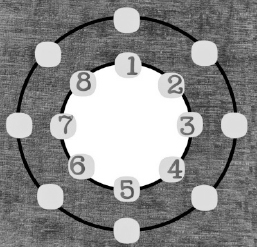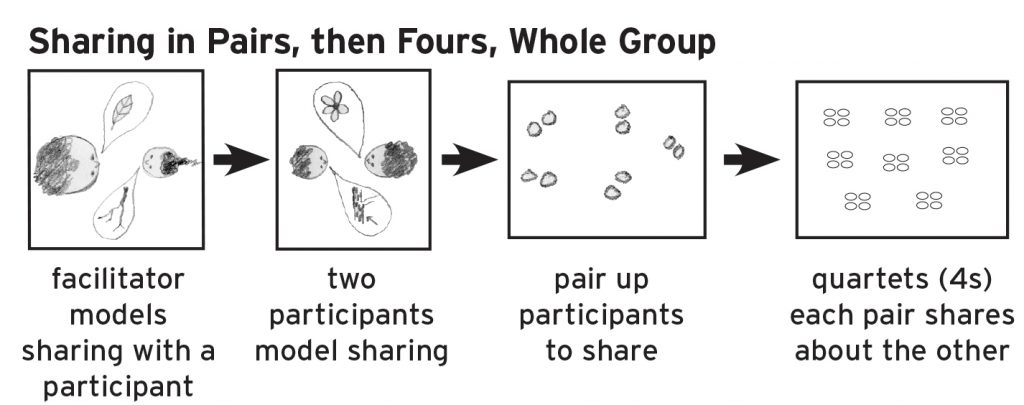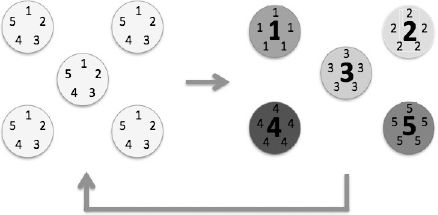Collaborative Learning Methods
“If you want to go quickly, go alone. If you want to go far, go together.”
–African Proverb
Collaborative Learning Methods is a relationship among co-workers and students developing:
- positive interdependence (a sense of sink or swim together),
- individual accountability (each of us has to contribute and learn),
- interpersonal skills (communication, leadership, decision making, & conflict resolution),
- face-to-face promotive interaction, and processing (reflecting on how well the team is functioning and how to function even better).
Think-Pair-Share
With Think-Pair-Share, the teacher poses a question or topic, preferable one demanding analysis, evaluation, or synthesis, and gives a person about a minute to think through an appropriate response. One person then turns to a partner and they share their responses.
Think Pair Share in Action
- facilitator models with participant — The facilitator/teacher can model behaviors such as what to do when you don’t know ideas or how to thread an idea from your partner.
- two participants model — The two students model understanding of the process and the classroom will be more attentive with the process watching their peers.
- all participants paired up — All involved holding all accountable.
- whole group shares — Have one person share one thing, then pick a student from a different location in the room.
In the extension below with quartets, when participants A&B join C&D,
A shares something learned from B, B from A,
C from D, D from C, back to A from B, and so forth…
Three-Step Interview
Common as a team-building exercise, this structure can also be used also to share information such as hypotheses or reactions to a film or article.
- People form pairs; one person interviews the other.
- People switch roles.
- The pair links with a second pair. This four-member learning team then discusses the information or insights gleaned from the initial paired interviews.
Learning Teams
Members of learning teams, usually composed of four individuals, count off: 1, 2, 3, or 4. The instructor poses a question, usually factual in nature, but requiring some higher order thinking skills. People discuss the question, making certain that every group member knows the agreed upon answer. The instructor calls a specific number and the team members originally designated that number during the count off respond as the group spokesperson. Because no one knows which number the leader will call, all team members have a vested interest in understanding the appropriate response. The verbalization and the peer coaching helps all learners become actively involved with the material.
Simple Jigsaw
The facilitator divides an assignment or topic into four parts with all people from each
Learning Team volunteering to become “experts” on one of the parts. Expert Teams then work together to master their fourth of the material and also to discover the best way to help others learn it. All experts then reassemble in their Home Learning Teams where they teach the other group members.
Home Learning Teams Expert Teams
Fishbowl
How It Works:
- Divide your class in half:
—one half will form the center circle, facing inward.
—the other half of the class will form the outer circle,
facing inward as well. - The students in the inner circle will discuss a predetermined topic.
- The outside circle will be listening to the discussion, taking notes and developing questions. They are only quiet observers at this point.
- The inner and outer circles then switch positions and repeat the steps above.
Why It Works:
 Eases Discussion Management: because only half the class is discussing at a time, this makes it much easier to manage than a whole-class discussion.
Eases Discussion Management: because only half the class is discussing at a time, this makes it much easier to manage than a whole-class discussion. - Promotes Active Listening: half the students have the specific role of listening to the inner circle. They understand that their turn to talk will come, which focuses them on active and attentive listening.
- Great for Discussion: the physical position of students makes it very clear when it’s time to listen and when it’s time to talk. You can switch through the roles a number of times during the discussions, and students have more incentive to listen when they are in the outer circle so that they can appropriately counter the points made from the inner circle.
- Peer Evaluation and Modeling: This model presents a valuable opportunity for students to evaluate their peers. Successful student presenters also serve as models to other students who are learning skills with class discussions.
“If you want to go quickly, go alone. If you want to go far, go together.”
–African Proverb
Collaborative Learning Methods is a relationship among co-workers and students developing:
- positive interdependence (a sense of sink or swim together),
- individual accountability (each of us has to contribute and learn),
- interpersonal skills (communication, leadership, decision making, & conflict resolution),
- face-to-face promotive interaction, and processing (reflecting on how well the team is functioning and how to function even better).
Think-Pair-Share
With Think-Pair-Share, the teacher poses a question or topic, preferable one demanding analysis, evaluation, or synthesis, and gives a person about a minute to think through an appropriate response. One person then turns to a partner and they share their responses.
Think Pair Share in Action
- facilitator models with participant — The facilitator/teacher can model behaviors such as what to do when you don’t know ideas or how to thread an idea from your partner.
- two participants model — The two students model understanding of the process and the classroom will be more attentive with the process watching their peers.
- all participants paired up — All involved holding all accountable.
- whole group shares — Have one person share one thing, then pick a student from a different location in the room.
In the extension below with quartets, when participants A&B join C&D,
A shares something learned from B, B from A,
C from D, D from C, back to A from B, and so forth…
Three-Step Interview
Common as a team-building exercise, this structure can also be used also to share information such as hypotheses or reactions to a film or article.
- People form pairs; one person interviews the other.
- People switch roles.
- The pair links with a second pair. This four-member learning team then discusses the information or insights gleaned from the initial paired interviews.
Learning Teams
Members of learning teams, usually composed of four individuals, count off: 1, 2, 3, or 4. The instructor poses a question, usually factual in nature, but requiring some higher order thinking skills. People discuss the question, making certain that every group member knows the agreed upon answer. The instructor calls a specific number and the team members originally designated that number during the count off respond as the group spokesperson. Because no one knows which number the leader will call, all team members have a vested interest in understanding the appropriate response. The verbalization and the peer coaching helps all learners become actively involved with the material.
Simple Jigsaw
The facilitator divides an assignment or topic into four parts with all people from each
Learning Team volunteering to become “experts” on one of the parts. Expert Teams then work together to master their fourth of the material and also to discover the best way to help others learn it. All experts then reassemble in their Home Learning Teams where they teach the other group members.
Home Learning Teams Expert Teams
Fishbowl
How It Works:
- Divide your class in half:
—one half will form the center circle, facing inward.
—the other half of the class will form the outer circle,
facing inward as well. - The students in the inner circle will discuss a predetermined topic.
- The outside circle will be listening to the discussion, taking notes and developing questions. They are only quiet observers at this point.
- The inner and outer circles then switch positions and repeat the steps above.
Why It Works:
 Eases Discussion Management: because only half the class is discussing at a time, this makes it much easier to manage than a whole-class discussion.
Eases Discussion Management: because only half the class is discussing at a time, this makes it much easier to manage than a whole-class discussion. - Promotes Active Listening: half the students have the specific role of listening to the inner circle. They understand that their turn to talk will come, which focuses them on active and attentive listening.
- Great for Discussion: the physical position of students makes it very clear when it’s time to listen and when it’s time to talk. You can switch through the roles a number of times during the discussions, and students have more incentive to listen when they are in the outer circle so that they can appropriately counter the points made from the inner circle.
- Peer Evaluation and Modeling: This model presents a valuable opportunity for students to evaluate their peers. Successful student presenters also serve as models to other students who are learning skills with class discussions.
Collaborative learning in action on video and a how to video.



